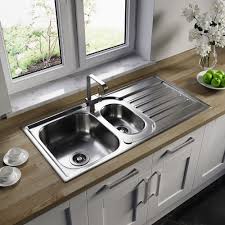How to Clean an Aluminium Sink: A Step-by-Step Guide
Aluminium sinks are a stylish and lightweight addition to any kitchen or laundry room, but they can become stained or tarnished over time if not properly cared for. Cleaning an aluminium sink requires gentle methods to avoid scratches and damage while effectively removing stains and buildup. Here’s a step-by-step guide on how to clean your aluminium sink and keep it looking shiny and new.
In this guide:
What You’ll Need
- Soft sponge or microfiber cloth
- Mild dish soap
- Baking soda
- White vinegar or lemon juice
- Soft-bristle brush (optional)
- Olive oil (optional)
- Clean, dry towel
Step 1: Rinse the Sink
Before starting the cleaning process, rinse the sink with warm water to remove any loose debris or food particles.
- Tip: Use warm water instead of hot, as extreme heat can damage the aluminium surface.
Step 2: Apply Mild Dish Soap
Use a mild dish soap to create a gentle cleaning solution.
- Mix Soap and Water: In a bowl, mix a few drops of mild dish soap with warm water.
- Wipe Down the Sink: Dip your soft sponge or microfiber cloth into the soapy water and gently wipe down the entire sink, paying special attention to any stained or dirty areas.
Step 3: Use Baking Soda for Stains
Baking soda is a natural abrasive that can help remove stubborn stains without scratching the aluminium.
- Sprinkle Baking Soda: After washing with soap, sprinkle a generous amount of baking soda over any stained areas of the sink.
- Scrub Gently: Use a damp sponge or soft-bristle brush to scrub the baking soda into the stains gently. The baking soda will act as a mild abrasive, lifting dirt and grime without scratching the surface.
- Rinse Thoroughly: Rinse the sink thoroughly with warm water to remove all baking soda residue.
Step 4: Use Vinegar or Lemon Juice for Extra Shine
For additional cleaning power and to restore shine to the aluminium, you can use white vinegar or lemon juice.
- Apply Vinegar or Lemon Juice: Spray or pour a small amount of white vinegar or lemon juice onto the sink.
- Let It Sit: Allow it to sit for a few minutes. This will help dissolve any mineral deposits or tarnishing.
- Wipe Clean: Wipe the sink with a soft sponge or cloth, then rinse thoroughly with water.
Step 5: Dry and Polish the Sink
To prevent water spots and maintain the shine of your aluminium sink, it’s essential to dry it properly.
- Use a Clean Towel: After rinsing, use a clean, dry towel to wipe down the sink completely. This will remove any remaining water and help prevent spots.
- Optional: Polish with Olive Oil: For an extra shine, you can apply a small amount of olive oil to a clean cloth and buff the sink lightly. This will enhance the shine and create a protective barrier against future stains.
Step 6: Regular Maintenance Tips
To keep your aluminium sink looking its best, consider these maintenance tips:
- Wipe Down Daily: After each use, give your sink a quick rinse and wipe down to prevent buildup.
- Avoid Harsh Cleaners: Stay away from abrasive cleaners, steel wool, and harsh chemicals, as they can scratch and damage the sink’s finish.
- Address Stains Quickly: Tackle any stains or spills promptly to prevent them from setting in and becoming harder to remove.
Cleaning an aluminium sink is a straightforward process that, when done regularly, can keep your kitchen looking fresh and inviting. By using gentle cleaning methods and avoiding harsh chemicals, you can maintain the beauty and functionality of your sink for years to come. If you prefer a deeper clean or are short on time, consider hiring a professional cleaning service like Go Cleaners London to help keep your home sparkling.
